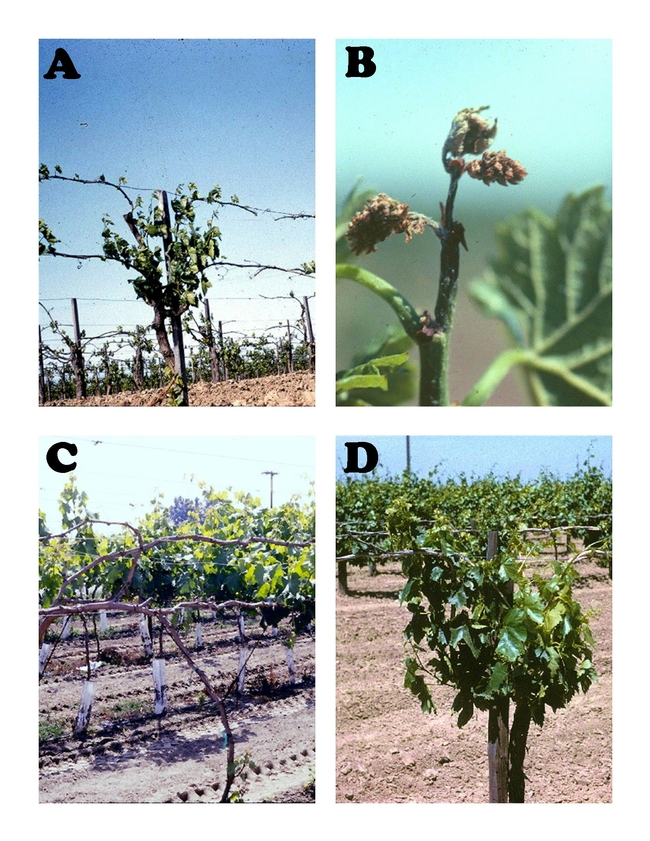To date, the San Joaquin Valley has only received 1.57 inches of precipitation this season (July 1 2011-June 30 2012) with none in December. The last time the San Joaquin Valley had such poor December rainfall was in 1999 and 2000, receiving 0.03 and 0.07 inches, respectively.
In both of the following springs, California grape growers observed severe delayed spring growth (DSG), the symptoms of which include irregular and poor bud-break and low shoot vigor. Entire vineyards were affected. Many of the vineyards that displayed erratic growth patterns were Thompson Seedless, but other varieties were also affected. Much of what we know about this phenomenon is from comparing cultural practices (e.g. irrigation), nutrient analysis, and site evaluation (e.g. soils and pests) in areas displaying DSG symptoms with non-symptomatic sites.
Symptoms
Symptoms of DSG vary in degrees of expression and at times may mimic other biotic (pest or disease) or abiotic (environmental) maladies. It is important to note that some of those maladies may also contribute to DSG depending on severity.
Symptoms of DSG include:
- Poor and uneven bud-break (Photo A)
- Stunted growth (Photo A)
- Smaller flower clusters or complete abortion of clusters (Photo B)
- Failure and ultimately death of individual buds (Photo C)
- Sucker growth at the base or head of the vine (Photo D)

Water Stress: A Predisposing Factor of Delayed Spring Growth
Inadequate water after harvest and through the winter is thought to induce DSG. After fruit harvest grapevines continue to assimilate carbohydrates and mineral nutrients which are needed to maintain health during dormancy and new growth the following season. Post harvest water stress can hinder those processes. Adequate soil moisture is also needed to rehydrate desiccated vine tissues in late winter, in preparation for bud break.
Normally after harvest a traditional flood-irrigated raisin vineyard has gone two months without water. Wine grape vineyards, depending on variety and harvest date, may also have long periods without being irrigated. Deciding when to irrigate a particular vineyard depends on many factors but soil type and vine vigor/health are probably most important. Sandy soils will be depleted of soil moisture much faster than finer textured soils, and vines may show symptoms of water stress while fruit matures or during the raisin drying process. Vineyards planted to finer textured soils may not show stress and often times do not need to be irrigated until later, when temperatures get cooler (October or November). This will prevent late season growth and encourage cane maturity.
Factors that should be considered when making decisions on late season irrigations:
- Soil type and problems
- Trellis type and canopy size
- Rootstock type
- Vineyard age
- Pest pressure
- Time of last irrigation
- Climatic conditions post harvest
- Climatic conditions during the winter
Poor winter rainfall can enhance DSG, especially when a post-harvest irrigation was not applied. A winter irrigation is strongly suggested when rainfall is less than an inch during the months of November and December. Note that mature vineyards maintained on drip irrigation do not suffer fluctuations between wet and dry and are able to begin storing carbohydrates during harvest, reducing water stress symptom. Young vineyards (1-3 years) should be irrigated when winter rainfall is minimal regardless of soil type.
Summary
Probably the most important factor in causing DSG is water availability post harvest and during the winter. Without available water during late summer, grapevines are unable to maintain a healthy canopy. This in turn hinders nutrient acquisition and photosynthesis, both needed for producing carbohydrate reserves in permanent wood structures used during dormant respiration and new growth the following season. When deciding on a post harvest irrigation or fertilization, soil type, vine vigor and health, and time of year should be taken into consideration. Assuring that a portion (at least 1/3) of the soil profile is re-wetted by mid November will also help to minimize the effects of cold damage.